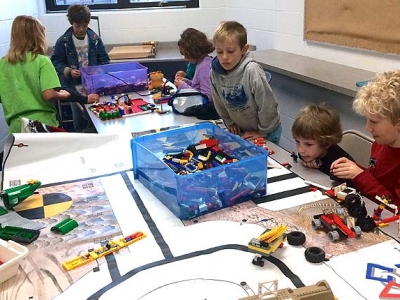Youth, elders dialogue about drug dogs, trust
- Published: December 25, 2008
According to several Yellow Springs youth, the schools and the village are not as supportive and inclusive of youth as they should be, and the youth need more of a voice in making the decisions that affect them. According to several Yellow Springs elders, the adult community makes the decisions necessary to keep youth safe, but the youth do need positive support and a place in town where they feel welcome. These were some of the opinions that were expressed at a meeting of 57 people who came to the Senior Center on Saturday, Dec. 20, to talk about youth in the community.
The discussion, sponsored by the Village Human Relations Commission, came on the heels of Yellow Springs High School’s decision to bring K9 units into the high school to search for illegal drugs on campus. School principal John Gudgel made the decision in consultation with Village Police Chief John Grote last month and sent a letter to all parents informing them of the new measure. School board members discussed the issue at a board meeting following the letter, but because the issue is not a policy issue but a building protocol, Gudgel has the ultimate authority to decide, School Board President Aida Merhemic and board member Anne Erickson said this week. Though she would have preferred to have a public discussion before the decision was made, the board will support the principal in the regulation of his building, Merhemic said.
The school board and school administration will continue the public discussion regarding drug dogs in the school at the next PTO meeting on Wednesday, Jan. 21, and again at the second board meeting of next month on Thursday, Jan. 22.
Many youth and adults expressed disappointment at Saturday’s meeting that the decision to use drug dogs had been made before a public discussion could take place. Recent YSHS graduate John Hempfling felt that the use of unannounced mass searches without individual suspicion violates students’ constitutional right to privacy and “turns schools into jailhouses,” he said, quoting a document from the American Civil Rights Union Washington chapter. Students aren’t against prohibiting drug use, said YSHS student Dylan Sage, but they are against intimidation tactics and criminalizing a problem that should be handled through counseling and education rather than through the courts.
Senior Ben Miller-Jacobson felt that drug dogs would only serve to decrease communication and create “an arms race between sneakiness and surveillance.”
Parents Abby Cobb, Lynn Sontag and Emily Fine agreed that drugs can pose a significant problem in the schools and the community, but that using drug dogs and the criminal justice system were not an effective response. The use of mass searches has a wide margin of error and could easily implicate an innocent student whose unused locker was being used by another student for drug storage, Fine said. Cobb suggested increasing open discussion with kids about drugs, acknowledging their need for “altered reality and spirituality” and trying to facilitate that search through means other than drug use.
But parent Karen Crist wondered why residents expect students should have rights to privacy at school, when adult employees don’t have it in the work place. From her perspective, drugs have caused enough serious damage in Yellow Springs that school and enforcement leaders should be allowed to do what they feel is needed to curb the problem.
And Gudgel and Grote both defended their choice to search with dogs, saying that over the years many other measures to reduce drug use in the schools have been and are being implemented, including substance abuse counseling and education, student surveys, informants, and educational and curricular modification. But these measures have not been able to create what school board policy mandates as a drug-free and safe environment.
“We have to be honest with ourselves,” and acknowledge that basic information gathering shows that some students have a drug problem, and “I strongly suspect are using on school grounds,” Gudgel said.
The school averages three to four substance abuse problems each year, according to Gudgel. When a student is found to have drugs at school, the parents are contacted, and the student is sent home immediately, along with being obligated to meet with a trained drug abuse counselor, Gudgel said. The student may be suspended for up to 10 days and subjected to regular testing and therapy. And though the school is obligated to inform police of a drug incident, unless it is a major offense, the police leave the school to handle the issue, he said.
“Our objective is to provide therapy and rehabilitation rather than destroy a student’s school career,” Gudgel said.
The intent is not to criminalize village youth, said Grote, who feels that courts aren’t an effective means of resolving drug abuse problems.
“Ninety-nine percent of the time I’ve felt the school can do a better job of taking care of the problem,” he said. “But the purpose for this decision is that I want there to be action behind the policy of a drug-free school.”
The use of drug dogs in the local schools has been considered as an additional intervention since the early 1990s, well before the 2002 drug-related murder of Tim Lopez by classmate Michael Rittenhouse, Gudgel said. The decision was not reactionary but rather a result of years of deliberation and investigation of the substance abuse problem at the school, he said.
But according to parent Judith Hempfling at the meeting, drug dogs will only serve to create distrust and alienate youth from adults who want to support them. The alienation at school is compounded when youth feel targeted by adults in the village at large, she said, referring to downtown patrons and businesses who have called police after feeling harassed or impeded by youth hanging out in the streets and sidewalks. The public bench that attracted groups of youth outside of Tom’s Market was removed to reduce complaints from the public, but the removal communicated to the youth that they are not wanted, Hempfling said.
“The bench was cool, but it was moved because of some minor problems, and instead of working out those problems, it’s a denial of teens’ rights to have a place there,” she said.
Many other adults at the meeting spoke overwhelmingly in support of making space for youth downtown and welcoming their energy in the public arena. With great passion, YSHS teacher Beth Lutz-Hackett advocated bringing youth into the fold by blocking off Short Street and creating a large town square.
“Teenagers are part of who we are — they need to have a place, and we want them to be downtown,” she said. “The benches should be there to welcome all people to be together as a community.”
Several youth at the meeting spoke in favor of establishing institutional empowerment for youth in the schools and the village. Recent YSHS graduates Rose Pelzl and Anna Forster advocated for support in maturing the recently created Yellow Springs Youth Council. The Youth Council could serve to organize and give voice to youth in defending their democratic rights and working with other agencies in the community, both said.
The Yellow Springs News encourages respectful discussion of this article.
You must login to post a comment.
Don't have a login? Register for a free YSNews.com account.

Parkinsons.jpg)













No comments yet for this article.